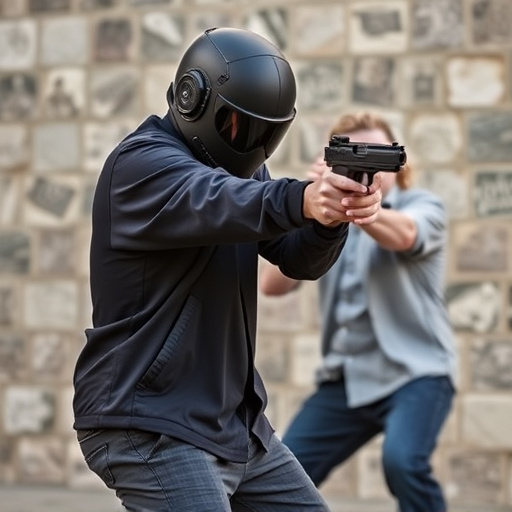Duration of Muscle Paralysis from Stun Guns: Neuromuscular Effects Explored
The neuromuscular effects of stun devices like Tasers stem from their disruption of nerve cell volta…….
The neuromuscular effects of stun devices like Tasers stem from their disruption of nerve cell voltage-gated sodium channels, preventing muscle contraction and causing temporary paralysis. The duration of muscle incapacitation varies based on device power output, contact area, individual characteristics, and application technique. While these effects last only seconds to minutes, they can pose safety risks in crowded areas or situations requiring quick reactions. Understanding the neuromuscular impacts is crucial for responsible stun device use and minimizing potential harm.
The neuromuscular disruption caused by stun guns has gained significant attention due to their growing popularity as personal defense tools. This article delves into the science behind how these devices affect muscles, focusing on the duration of muscle incapacitation. We explore various factors influencing this duration and emphasize the importance of safety considerations, including impacts on targeted individuals and surrounding environments. Understanding the neuromuscular effects of stun devices is crucial for both users and law enforcement.
- Understanding Neuromuscular Disruption: How Stun Guns Affect Muscles
- Duration of Muscle Incapacitation: Factors and Variations
- Safety Considerations: Impact on Targeted Individuals and Surroundings
Understanding Neuromuscular Disruption: How Stun Guns Affect Muscles

Stun guns, also known as Tasers, work by delivering a strong electric current through two small probes attached to the device. This electric shock disrupts the neuromuscular transmission in the targeted individual, leading to muscle incapacitation. The neuromuscular system is responsible for communicating signals from the brain to the muscles, allowing us to move and perform various tasks. When a stun gun interrupts this process, it causes involuntary muscle contractions, leading to temporary paralysis or “stun.”
The effects of stun guns on muscles are primarily due to their impact on voltage-gated sodium channels in nerve cells. By depolarizing these channels, the devices prevent nerve impulses from traveling to the muscles, resulting in a rapid and intense response. The duration of muscle incapacitation varies depending on the model of the stun gun, the number of jolts administered, and individual factors like body size and health. However, it’s important to understand that while stun guns provide a non-lethal means of self-defense or law enforcement control, they do not render a person completely helpless indefinitely.
Duration of Muscle Incapacitation: Factors and Variations

The duration of muscle incapacitation caused by stun guns can vary significantly due to several factors related to both the device and the target individual. The neuromuscular effects of stun devices aim to disrupt normal nerve function, leading to temporary paralysis or incapacity. However, these effects are not constant across all users or situations.
Key variables include the power output of the stun gun, the contact area with the target’s body, and the target’s overall health and physical condition. Higher voltage outputs typically result in longer periods of incapacitation, often ranging from several seconds to a few minutes. Proper application techniques, ensuring direct contact with larger muscle groups, can also enhance the neuromuscular effects, leading to prolonged muscle relaxation. Conversely, individuals with higher tolerance or certain medical conditions might experience shorter durations of muscle incapacitation despite similar stun gun settings.
Safety Considerations: Impact on Targeted Individuals and Surroundings

The neuromuscular effects of stun devices, including their impact on muscle incapacitation duration, raise important safety considerations. When deployed, stun guns temporarily disrupt muscular control by impairing nerve signals to muscles, leading to a loss of balance and strength. This disruption can last from several seconds to a few minutes, depending on the device’s power and the target’s tolerance or resistance. However, this temporary muscle incapacitation can have significant consequences for targeted individuals and their surroundings.
For individuals affected, the immediate aftermath involves a period of disorientation and reduced mobility. In crowded settings or public spaces, this could lead to falls, collisions, or accidental injuries to both the targeted person and bystanders. Moreover, prolonged muscle paralysis may pose risks in scenarios where quick reactions are necessary, such as escaping from hazardous environments or avoiding sudden threats. Understanding these neuromuscular effects is crucial for ensuring responsible use of stun devices, promoting safety during their deployment, and mitigating potential harm to individuals and communities.
The neuromuscular effects of stun devices, particularly their impact on muscle incapacitation duration, are multifaceted. Understanding how these tools disrupt muscular function and the factors influencing this duration is crucial for both safety and effective deployment. By considering environmental conditions, individual physiology, and the specific type of stun device used, we can better navigate the safety considerations surrounding these devices. It’s important to note that while they can temporarily disable individuals, their effects are not permanent, and proper training and regulation ensure responsible use.


